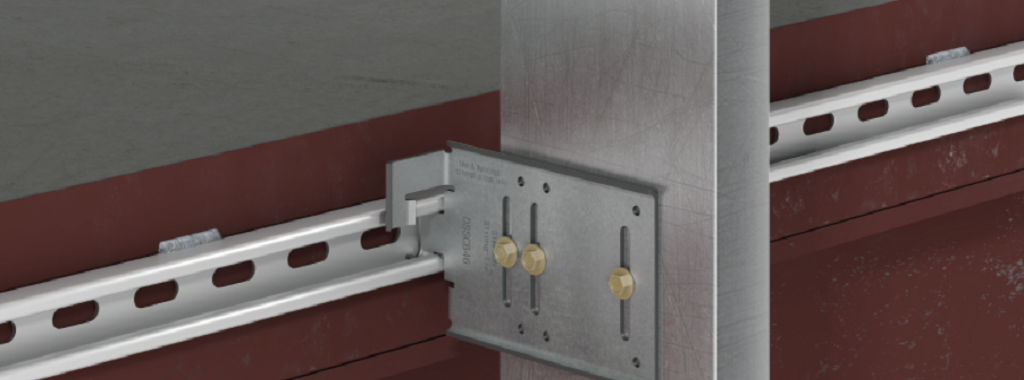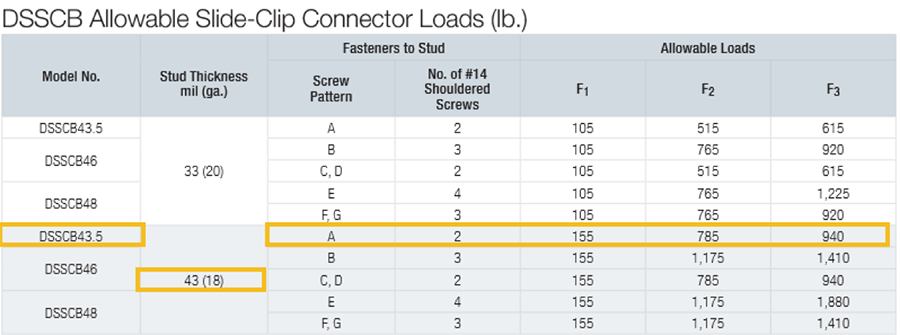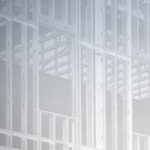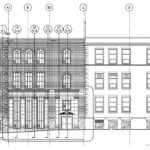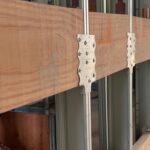Structural engineers concerned with building envelopes are always looking for better solutions that help isolate the cladding from the primary structure in conditions where large building drift is a concern. Simpson Strong-Tie has an answer with a unique and innovative solution, the new DSSCB (drift strut sliding clip bypass).
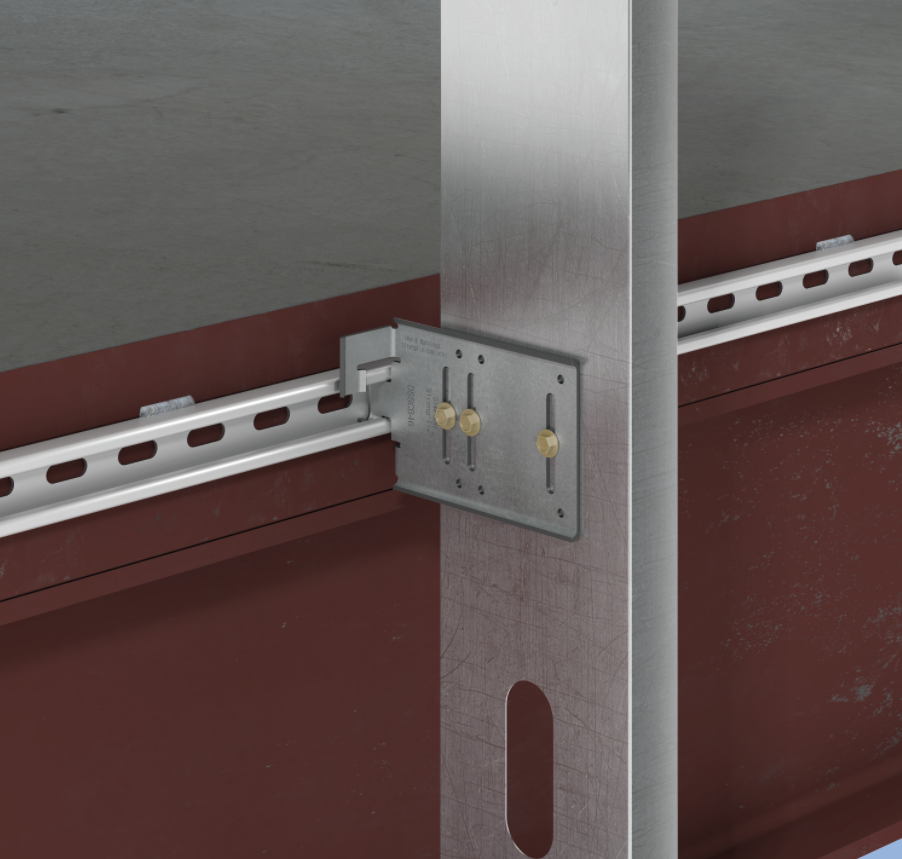 The DSSCB is used to anchor cold-formed steel framing to the primary structure in bypass applications. The DSSCB is a clip that slides inside standard struts that most engineers and contractors are already familiar with. These struts will typically be attached to structural steel. However, there is also a cast-in-place strut option referred to as a strut insert. Many different manufacturers of these struts exist, but three common manufacturers are Unistrut®, PHD and B-line. The strut and strut insert requirements for the DSSCB can be found in the Simpson Strong-Tie DSSCB flier (F-CF-DSSCB17).
The DSSCB is used to anchor cold-formed steel framing to the primary structure in bypass applications. The DSSCB is a clip that slides inside standard struts that most engineers and contractors are already familiar with. These struts will typically be attached to structural steel. However, there is also a cast-in-place strut option referred to as a strut insert. Many different manufacturers of these struts exist, but three common manufacturers are Unistrut®, PHD and B-line. The strut and strut insert requirements for the DSSCB can be found in the Simpson Strong-Tie DSSCB flier (F-CF-DSSCB17).
The DSSCB has many design features that make it easy to use, cost-effective and designer-friendly.
- The DSSCB clip has uniquely formed inserts that twist into place easily with minimal friction
- The clip features squaring flanges that help keep the clip square inside the strut
- Shoulder screws (included) prevent over-drilling and increase overall capacity
- Pre-engineered design offers clip, strut and anchorage solutions
- Pre-punched slots provide a full 1″ of both upward and downward deflection
- Sight lines facilitate proper screw placement
The DSSCB is also a hybrid clip and accompanies both slide applications as well as fixed applications. In addition to vertical slots, the clip also has round circular holes for fixed-clip conditions. This will make the clip more versatile and limit inventory.
Another great use for this product is for panelized construction. The DSSCB makes it a snap to anchor finished panels to the slab without having to waste time drilling and installing anchors. Locking panels into place is also simple with a DSHS connector clip that can be easily slid into place and attached with only one (1) #10 screw.
Accommodating for building drift and commercial panel construction just got easier with the Simpson Strong-Tie DSSCB!
Design Example
Load required at bypass slide condition attached to steel with ASD reactions of 450 lb. tension (F2) and 422 lb. compression (F3) – based on CFS DesignerTM software or hand calculations
Stud member = 600S162-43 33 ksi at 16″ o.c. – based on CFS Designer software or hand calculations
Per page 4 of the DSSCB flier (F-CF-DSSCB17), allowable F2 = 785 lb. and F3 = 940 lb. for slide-clip connector (shown below)
Per page 7 of the DSSCB flier (F-CF-DSSCB17) allowable loads of F2 = 475 lb. and F3 = 2,540 lb. for strut allowable anchorage with 1″ weld at 12″ o.c. using a 13/16″ strut (shown below)
Note that, at a strut splice (if required), maximum load is not to exceed F2 of 865 lb. per note 6 on page 7 (shown below)
6. For any connector occuring within 2″ of channel strut splice, load not to exceed — F2 = 865 lb. and F4 = 785 lb.
Check connector and strut/anchorage:
F2 (tension): Pmax = 450/ minimum of (785,475) = 0.95 < 1 ok
F3 (compression): Pmax = 422/ minimum of (940,2540) = 0.45 < 1 ok
FAQs:
Q: How are the products sold?
A: The clips are sold in kits of 25. For the DSSCB43 and DSSCB46, one polybag of 83 screws is included. For the DSSCB48, two 55 screw polybags are included. The DSHS will be sold separately from the clips and come in bags of 100. The struts will not be sold by Simpson Strong-Tie.
Q: Can I use the 1 5/8″ x 1 5/8″ strut for the fixed-clip application?
A: No, the fixed-clip application was tested only with the 13/16″ x 1 5/8″ strut. The 1 5/8″ x 1 5/8″ strut would overhang more, which we calculate could reduce capacities.
Q: When should I use the DSHS clip?
A: The DSHS clip should be used where you want to fix the clip in place in the F1 (in-plane) direction. This clip will most likely be used for panelizing, but could be used for stick framing as well when adjustment is required before locking the clip in place.
Q: Why are there two tables that I need to use to determine my connector capacity?
A: One table is for the capacity of the clip, and the other table is for the capacity of the strut/anchorage. Two tables give the designer more flexibility in the design as well as an understanding of what is controlling the failure.
Q: How do I accommodate load requirements at a strut splice?
A: Note 6 to the Strut Channel Allowable Anchorage Loads to Steel table states the capacity of the strut with a clip directly at the splice. The values are based on assembly testing. Refer to page 7 of the flier.
Q: How do I accommodate load requirements at the strut end?
A: Note 10 to the Strut Channel Allowable Anchorage Loads to Steel table states that the connector load is to be located a minimum of 2″ from the end of the strut channel. Note 2 to the Concrete Insert Allowable Load Embedded to Concrete table gives a reduction capacity for end conditions. Reference pages 7 and 8 of the flier.
Q: Why do we show an F1 load on a drift clip?
A: The drift clip without the DSHS does not support any load in F1 direction. F1 load is only supported if a DSHS clip is used in conjunction with the DSSCB clip. This is also noted (note 4) on the DSSCB Allowable Slide-Clip Connector Loads and the DSSCB Allowable Fixed-Clip Connector Loads tables. Refer to pages 4 and 6 of the flier.
Q: How do I accommodate higher concentrated loads at jambs exceeding my typical stud loads?
A: Note 7 to the Strut Channel Allowable Anchorage Load to Steel table gives the capacity of the strut/anchorage if the strut is welded directly at the clip. Refer to page 7 of the flier.
Q: Can I drive PAFs into my strut?
A: No. The shot pin tool will not fit inside the strut channel.
Q: If I want to attach my strut to the steel edge angle with screws, what brand should I use?
A: Simpson Strong-Tie makes great fasteners, and we would recommend these fasteners (#12-24 Strong-Drive® Self-Drilling X Metal screw). However, you can use any brand fastener provided they meet our Pss and Pts capacities minimum nominal strength values in General Notes for Allowable Connector Load Tables on page 8 of the flier.
Q: At a double-stud condition, is it acceptable to double the capacity if I use two (2) clips?
A: It is acceptable to double the capacity of the DSSCB slide-clip or fixed-clip table loads (pages 4 and 6 in flier). However, the load should not exceed the load listed in the Strut Channel Allowable Anchorage Loads to Steel table (page 7 in flier). If a load is exceeded, please follow note 7 on page 7 of the flier by adding a weld connection directly at the concentrated load. This will allow you to have a wider anchor spacing for your typical studs and only reinforce the higher concentrated loads with connections directly at these locations.

